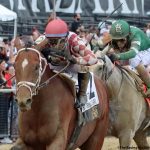In Maryland, pondering a “synthetic” future
Is a synthetic surface in Maryland racing’s future?
The answer to that – as to virtually every question about the industry’s future in the Free State – remains unknown. But it’s clear the Maryland Thoroughbred Racetrack Operating Authority will give the surfaces – once derided as “plastic” by horsemen and now believed by many to be critical to the industry’s future – a long look.
At its October 20 meeting, the Authority, a body created by the state’s General Assembly to envision the future for Maryland racing, heard from Lisa Lazarus, chief executive officer of the federally-created Horseracing Integrity and Safety Authority, and NYRA executive vice president of operations and capital projects Glen Kozak. Central to the discussion: synthetic surfaces.
“We’re tasked in part with looking at a new facility, a new training center,” Authority chairman Greg Cross said to Lazarus. “You’re studying track surfaces… Are you pointing to a conclusion of some sort?”
Lazarus demurred.
“We’re collecting a lot of data. We don’t have a conclusion yet,” she said. “But we certainly have, I think, hypotheses to start with.”
Synthetic surfaces have had consistently lower equine fatality rates under racing conditions, according to Equine Injury Database data. During 2022, there were 0.41 fatalities per 1,000 racing starts on synthetic surfaces. That compared favorably with the rate for dirt (1.44) and even that for turf (0.91).
But an industry experiment with synthetics blew up several years ago, with Southern California tracks and Kentucky’s Keeneland all peeling off their synthetics and reverting to conventional dirt surfaces. A handful of North American tracks, Woodbine perhaps most prominent among them, retain synthetic as their “main track,” while other tracks, such as Gulfstream Park, have synthetic surfaces alongside conventional dirt and turf tracks.
NYRA’s Belmont Park is soon to join that latter group, Kozak said. Belmont, in the midst of a massive project that will see its enormous grandstand demolished and replaced with a building about a quarter the size, is also renovating its racing strips. When all is said and done, it will still have its famed, mile-and-a-half dirt course, along with two turf courses inside of it and a one-mile synthetic course inside of them.
CHECK OUT THE LATEST OFF TO THE RACES RADIO!
Kozak pointed to two benefits of adding synthetic. One is its value as a stand-in when races come off the turf; NYRA has been off the turf virtually every weekend since the end of the Saratoga meet. “Seven weekends in a row” of rain, Kozak noted.
“One of the key things for us with the Tapeta [surface] and having the ability for that all-weather surface is how turf-oriented NYRA has become over the years,” Kozak said. “When we’re carding five or six turf races a day, having the ability to have a surface that we can come off of from the turf racing, not only for the wagering aspect of it but also for the health and the care of that surface.”
Laurel Park, with its spacious turf course, cards numerous grass races per day during turf season. Pimlico, with a smaller and older course, cannot.
NYRA installed Tapeta on its quarter-mile “pony track,” primarily used for jogging horses, last year, and Kozak said that the surface’s resilience in the face of bad weather has been particularly notable.
“The thing about the synthetic that we found with now almost a year’s worth of real-time use is how consistent the surface is for the weather conditions that impact it, for snow, for rain, even for the heat,” he said.

Kozak showed the group slides he said showed the synthetic and dirt courses shortly after a heavy rain. The former looked clean and smooth, while the latter was dotted with puddles of standing water.
Some horsemen believe that, though fatalities may be less prevalent on synthetic, soft-tissue injuries are more common. But Kozak said he believes that’s more of a matter of horsemen learning how to train on synthetics and operators learning how to maintain them.
Now, he said, the pony track is seeing a significant uptick in its business.
“It’s something that they have to get adjusted to,” he said. “We started out when [the Tapeta pony track] was installed with roughly about 100 to 125 horses going out on it per day. We’re up to 350 now, and the most was 369, out of 1,700 horses stabled on that track.”
So, synthetic surface, here Maryland comes. Right?
Maybe, but not so fast. NYRA’s Belmont project is a massive undertaking – with a massive budget – at a facility that’s nearly 400 acres and easily big enough to consolidate racing. All of that makes it enormously different from Maryland’s project, where it appears most likely that the 100-plus-acre Pimlico will survive as the primary racetrack, necessitating the development of a training center.
“Obviously, at Belmont you have substantial funding to do the project that you’re doing, and you have a lot of land and you’re able to consolidate,” said Authority member and Maryland Thoroughbred Horsemen’s Association general counsel Alan Foreman. “Here we have limited funds. We have to build a training center, we believe we have to. And Pimlico is not big enough to consolidate racing.”
And that’s to say nothing of the questions the Authority examined in its two prior meetings: who should operate the tracks, and under what ownership arrangement?
How the Authority threads those needles will go a long way to determining Maryland racing’s future. Its report to the General Assembly is due December 1.
Its next meeting is scheduled for Wednesday, November 1 at noon.
LATEST NEWS














